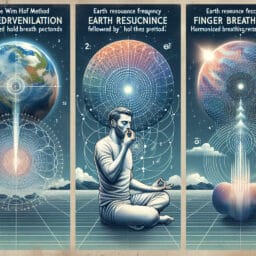
Understanding the Concept: Defining Grounding in Meditation
Table of Contents
- Introduction to Grounding in Meditation
- Understanding Grounding in Meditation
- The Process of Grounding in Meditation
- Benefits of Grounding in Meditation
- Common Mistakes in Grounding and How to Avoid Them
- Conclusion
Introduction to Grounding in Meditation
In the bustling world we inhabit, it can be challenging to maintain a strong connection with our physical bodies and the environment around us. This is where grounding exercises in meditation come into play, serving as a powerful tool for re-establishing this vital link. Grounding in meditation involves bringing your attention back to your body and what’s happening around you at the present moment. It’s about allowing yourself to feel a physical connection with the earth, anchoring yourself firmly within your body and environment.
Grounding techniques are an integral part of mindfulness meditation. They help divert focus from negative emotions or stray thoughts, thus promoting overall mental well-being. Considered as one of the most effective methods for dealing with anxiety and stress, grounding techniques often utilize elements from our physical world to draw us back into reality – whether that’s feeling the texture of an object or focusing on breath control.
One popular grounding technique is body scan meditation which involves paying close attention to different parts of your body starting from the feet and moving upwards. Another simple yet powerful approach is tree meditation; visualizing oneself as a tree trunk extending deep into the ground can help center one’s energy. You begin by sitting directly on solid ground and taking deep breaths while envisioning light coming down through you like nourishment soaking into a tree trunk traveling downwards.
When practicing grounded meditation, make sure that you’re seated in a quiet place where you won’t be disturbed easily – somewhere you feel connected to nature could work wonders! Visualize roots extending from your feet firmly planted on the ground; let those roots absorb excess energy resulting from stress or anxiety.
A key aspect of grounding is learning how to breathe slowly yet deeply; inhale through your nose slowly then exhale gently through your mouth – it should feel effortless yet refreshing! As you do this, relax every muscle in your body starting from top-to-bottom until each part feels completely at ease.
Understanding how our mind wandering affects our physical body and how to bring our attention back to the centre point of our existence is pivotal. This awareness can help us manage stress more effectively in daily life, making grounding techniques an essential part of any meditation practice.
In conclusion, grounding exercises provide a holistic approach for connecting with the physical environment and oneself. They’re not just about calming your mind but also about ensuring that your body feels grounded and centered. Remember, it’s not something you perfect overnight – like any other skill, it requires practice and patience! So start incorporating these techniques into your guided meditation sessions today and observe how meditation changes your relationship with yourself and the world around you.
Understanding Grounding in Meditation
Grounding in meditation techniques is more than just a simple practice; it’s a transformative journey that brings us back to the present moment and enables us to forge a strong connection with our physical body and environment. By anchoring ourselves firmly in our surroundings, we create an energetic link between our physical world and our inner selves. Grounding exercises serve as an effective method for grounding oneself, offering a powerful tool with significant benefits.
Consider the enlightening aspects of mindfulness meditation, where we pay close attention to what’s happening around us and within us. We allow ourselves to become acutely aware of each breath, feeling it flow gently into our lungs and then release slowly through the nose. This deep breathing technique alone can help diminish negative emotions and divert mind wandering towards calmness.
And there are even more layers of practices in grounding meditation that enhance its effectivity. One such layer involves body scan meditation—focusing on various parts of one’s physique from feet upwards—a process that brings your attention back to your centre point while also stimulating awareness about how different parts of your body feel at any given time.
Another intriguing approach is tree meditation where you visualize yourself as a tree trunk extending into the earth, drawing energy from it while also providing stability and strength like an old oak standing tall against windstorms. As you sit directly on ground close enough to imagine roots extending from your feet firmly planted, feelings of stress or anxiety begin to dissipate as if absorbed by nature itself—the excess energy resulting from these negative feelings grounded out effectively.
Beyond these rich visualization methods lies earthing—a practice centered around making direct contact with earth surfaces—which further augments this sense of connectedness underpinning grounding techniques. Through earthing experiences, we can attune ourselves more deeply with nature’s rhythms while gaining profound insights about how profoundly meditation changed relationships between self & surroundings over time.
As you continue exploring grounding techniques through guided meditations in a quiet place conducive for deep breathing, you’ll breathe in new possibilities for managing stress and enhancing well-being. The practice of grounded meditation becomes a beacon guiding us back to our physical sensations, anchoring firmly in the present moment – a powerful testament to the transformative potential that lies within grounding itself. So engage fully with this journey; it’s not just about how grounding benefits one’s daily life but also about how it reshapes our understanding of existence and connection to the world around us.
| Understanding Grounding in Meditation | |
|---|---|
| Grounding techniques | These are methods used to anchor oneself in the physical environment, creating an energetic link between the physical world and the inner self. They are transformative practices that help bring us back to the present moment. |
| Mindfulness meditation | A type of meditation where attention is paid to what is happening both internally and externally. It involves deep breathing techniques that help reduce negative emotions and increase calmness. |
| Body scan meditation | A method that involves focusing on different parts of the body from feet upwards, bringing attention back to the center point while stimulating awareness about how different body parts feel at any given time. |
| Tree meditation | A visualization process where one imagines being a tree trunk extending into the earth, drawing energy from it while providing stability and strength. This method helps dissipate feelings of stress or anxiety. |
| Earthing | A practice centered around making direct contact with earth surfaces, enhancing the sense of connectedness and attuning oneself more deeply with nature’s rhythms. |
| Benefits of grounding techniques | These techniques not only offer possibilities for managing stress and enhancing well-being, but also reshape our understanding of existence and our connection to the world around us. |
The Process of Grounding in Meditation
Grounding in meditation is a transformative journey that involves harnessing the power of mindfulness techniques to anchor us in our physical environment and connect us with our body. This practice, when done correctly, can enhance our understanding of existence and reshape our relationship with the world around us. Grounding exercises such as body scan meditation are effective tools for guiding our attention back to the centre point of our existence. As we sit directly on solid ground in a quiet place, we visualize ourselves extending deep into the earth like a sturdy tree trunk. This simple yet powerful visualization method draws us back into reality, making us acutely aware of what’s happening within and around us at any given moment.
In this process, taking deep breaths is key: draw air slowly through your nose then gently exhale it out through your mouth while focusing on how each part of your body feels—the sensations flowing downward from your head to toes like light coming down through you. The grounding process also involves earthing—making direct contact with earth surfaces—which further augments this sense of connectedness underpinning grounding techniques.
As you engage more deeply with these practices during guided meditation sessions, you’ll notice how grounding helps manage stress by diverting focus from negative emotions or stray thoughts that lead to mind wandering. It is about letting go and giving yourself permission to be fully present in the moment without any judgment or expectation. As you continue practicing grounded meditation over time consistently, not only does it become an effortless part of daily life, but it also transforms how mindfulness changes your outlook towards stress management.
Remember that grounding isn’t about achieving perfection; it’s about fostering a strong connection between yourself and the physical world around you—one that keeps bringing your attention back to where it belongs: Here and now! And as this connection strengthens over time—thanks to consistent practice—you’ll find yourself better equipped at handling life’s ups and downs calmly & resiliently.
Embrace grounding exercises wholeheartedly, observe their effects on your mental and physical well-being, and pay attention to the subtle shifts in how you relate to yourself and the world around you. The journey may be slow, but every step is a powerful testament to the transformative potential that lies within grounding in meditation techniques. So why wait? Start today, ground close to nature’s heartbeats—and watch as each breath you take brings more peace, balance, and clarity into your life.
Benefits of Grounding in Meditation
Grounding in meditation techniques is more than just a simple meditation technique—it’s a transformative journey that cultivates a physical connection to the earth, calms negative emotions, and fosters an indomitable strong connection with oneself. This mindful practice requires you to sit directly on the ground, close your eyes, and focus on what’s happening within your physical body—feeling each breath entering through the nose slowly and leaving gently with every exhale. As these deep breaths flow into your stomach, you relax and focus on each part of the body as it feels at that very moment—this is often called body scan meditation.
This grounding process isn’t limited to just calming your mind; it also has profound benefits for both physical health and mental well-being. For instance, grounding exercises can help manage stress levels in daily life by guiding attention back from wandering thoughts or worries towards present moment awareness—a feat achieved by maintaining a steady stream of deep breaths filling not only your lungs but also bringing light into every cell of the body.
Furthermore, earthing—a practice where we make direct contact with earth surfaces—helps ground excess energy resulting from anxiety or tension. By imagining roots extending from one’s feet firmly planted into the ground like a tree trunk travelling deep down—the visualization method central to tree meditation—you anchor yourself physically while letting nature absorb any disturbances rippling across your emotional landscape.
As you continue practicing grounded meditation guided by these instructions in a quiet place conducive for mindfulness exercises over time consistently, not only does this become an effortless part of day-to-day routine but also reshapes how mediation changes our relationship with ourselves and the world around us—an insight many derive after diligent practice spread over weeks or months.
So don’t dither! Embrace this powerful tool today in your meditation practice: start sitting directly on solid ground close enough to feel its steadiness beneath you; breathe slowly yet deeply while focusing on how different parts of your body feel at any given moment. Let these grounding techniques, whether it’s the body scan meditation or tree visualization, serve as pathways welcoming you back home to the present—where every breath holds potential for immense peace and tranquility while each heartbeat pulses with boundless joy and vitality!
| Benefit | Description |
|---|---|
| Physically Grounding | By sitting directly on the ground during meditation, you cultivate a physical connection to the earth. |
| Emotional Stability | Grounding in meditation calms negative emotions and fosters a strong connection with oneself. |
| Body Scan Meditation | This mindful practice focuses on each part of the body individually, helping you to relax and be present. |
| Stress Management | Grounding exercises can guide attention back from wandering thoughts or worries towards present moment awareness. |
| Earthing | Making direct contact with earth surfaces can help ground excess energy resulting from anxiety or tension. |
| Tree Meditation | Visualizing roots extending from one’s feet firmly planted into the ground can help anchor oneself physically and emotionally. |
| Consistent Practice | With consistent practice over time, grounded meditation can become an effortless part of day-to-day routine and can reshape our relationship with ourselves and the world. |
Common Mistakes in Grounding and How to Avoid Them
Grounding in meditation techniques is not just a simple meditation technique, it’s an empowering journey that cultivates both physical connection and emotional stability. It provides effective methods to manage stress, guiding wandering minds back to the present moment through mindfulness meditation. The process begins when you sit directly on the ground in a quiet place, fostering a strong connection with your physical environment. As you close your eyes and take deep breaths slowly through your nose and exhale deeply through your stomach, you start to relax and focus on how each part of your body feels at the present moment—a central aspect of body scan meditation.
However, becoming proficient in grounding exercises requires consistent practice; it’s crucial not to overthink but rather allow yourself to flow naturally into these practices. One common pitfall is losing focus during guided meditation sessions due to negative emotions or distractions around you. To circumvent this, visualize light coming down through you as if soaking into a tree trunk traveling downwards—an engaging visualization method used in tree meditation.
Consistency is key for grounding oneself effectively—each session enhances how mindfulness changes one’s perception of daily life. So whether it’s earthing or tree visualization techniques—embrace these powerful tools today and observe the profound impact they have on reshaping our relationship with ourselves and our physical world.
Conclusion
Grounding meditation techniques are powerful tools that foster a strong connection between our physical body and the environment, anchoring us firmly in the present moment. Through simple yet effective methods such as body scan meditation, we learn to direct our attention back to our physical sensations, observing what’s happening within us with each deep breath. This practice not only calms negative emotions but also helps manage stress in daily life. When we sit directly on solid ground, close to nature in a quiet place and visualize light coming down through us like nourishment soaking into a tree trunk traveling downwards, we effectively ground excess energy resulting from anxiety or tension. With consistent practice of grounded meditation exercises, mindfulness reshapes our relationship with ourselves and the world around us—profoundly changing how we perceive stressors and challenges. It becomes an effortless part of our routine, transforming each day into an experience of peace and tranquility. So why wait? Begin your grounding journey today; it’s more than just a simple meditation technique—it’s a pathway to enhanced well-being.

Q: What is Meditation and why is it important?
A: Meditation is a technique that involves focusing the mind on a particular thought, object, or activity to train attention and awareness, and achieve a mentally calm and stable state. It is vital as it helps individuals develop concentration, become more aware, reduces stress and anxiety, and promotes emotional well-being.
Q: What is the concept of Grounding in Meditation?
A: Grounding in meditation is a process that helps individuals root or anchor their energy with earth, creating a feeling of being centered and balanced. This concept promotes relaxation, emotional balance, and helps keep the body and mind in the present moment rather than dwelling on past worries or future anxieties.
Q: What is the scientific perspective behind Grounding in Meditation?
A: From a scientific perspective, grounding helps decrease levels of cortisol, the stress hormone, and increases the release of positive hormones like serotonin and dopamine. This not only makes the body feel calm and relaxed but also helps retain a positive mindset.
Q: How can grounding techniques enhance my meditation practices?
A: Grounding techniques can enhance your meditation practices by keeping the body connected and in sync with the present moment. They’ll not only increase mental focus but also help reach new levels of spiritual and emotional growth.
Q: How can I prepare for Grounding in Meditation?
A: Preparing for grounding involves finding a comfortable and quiet space, assuming a comfortable sitting posture and focusing on being present. Practicing certain breathing techniques can also be beneficial.
Q: What are some common mistakes in grounding and how can I avoid them?
A: Some common mistakes in grounding include overthinking, inconsistency and not being fully present during the practice. It’s essential to maintain regular grounding practices and focus on present sensations, thoughts, and emotions to avoid these pitfalls.
Q: What are the benefits of Grounding in Meditation?
A: Grounding in meditation offers both physical and mental benefits. It can help reduce stress and anxiety, improve sleep, increase concentration, enhance emotional well-being, and even provide physical benefits related to blood circulation and energy levels.
Q: How can grounding be incorporated into daily life?
A: Grounding can be incorporated into daily life by habitually paying more attention to your physical sensations, and your connection to the world around you. You can practice grounding while walking, sitting, eating, or even while interacting with others.
Q: What are some strategies to avoid overthinking during meditation?
A: To avoid overthinking during meditation, focus on your breath or a chosen object of attention. When distracting thoughts arise, gently recognize them, then return your attention to the present moment. It’s also beneficial to let go of expectations and accept whatever arises during your practice.



